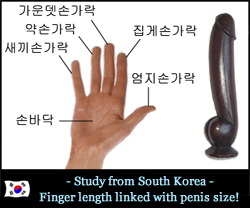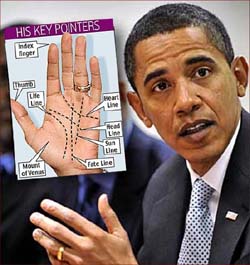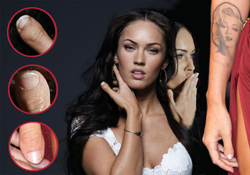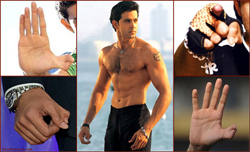Scientific ‘fingerology’ may help you to identify your potential for success… or failure!
October 16, 2012
 Scientific ‘fingerology’ may help you to identifiy your most likely potential for success… or failure via the ratio of only two fingers. What is your 2D:4D digit ratio?
Scientific ‘fingerology’ may help you to identifiy your most likely potential for success… or failure via the ratio of only two fingers. What is your 2D:4D digit ratio?
More blogging-reports are available at:
The Finger length & Digit Ratio blog
PS. Your digit ratio can be seen as a measure for prenatal testosterone, which explains why this finger-measure correlates with many aspects in life!

Last summer professor John T. Manning re-designed his popular 2D:4D digit ratio theory about finger length ratio development in the hand. While he had already mentioned the role of prenatal sex steroids, now the updated theory now focusses on the balance between sexe hormones (androgens) testosterone & oestrogen during the development in the whomb!
Professor Manning presented his revised theory in the PNAS magazine under the title: ‘Resolving the role of prenatal sex steroids in the development of digit ratio‘.
Manning’s new working hypothesis now includes e.g. the following 7 key-elements:
1 – The 2D:4D digit ratio results from the balance between prental androgens testosterone & estrogen;
2 – A high 2D:4D digit ratio results from relatively low testosterone concentrations – OR relatively high estrogen concentrations;
3 – A low 2D:4D digit ratio results from relatively high testosterone concentrations – OR relatively low estrogen concentrations;
4 – The ring finger (= digit 4D) is featured with many more hormone receptors compared to the index finger (- digit 2D), therefore the 2D:4D digit ratio is mostly driven by changes in the length of the ring finger (due to prenatal hormone concentrations);
5 – Studies in human & animals indicate that the link between prenatal androgens and 2D:4D digit ratio is generally stronger for the right hand;
6 – 2D:4D Digit ratio varies with sexe: males generally have longer fourth digits relative to second digits than females;
7 – 2D:4D Digit ratio varies with ethnicity.
A quote from Manning’s article:
“Armed with this list of skeletogenic genes linked to 2D:4D, we can now be more focused in our examination of the links between 2D:4D and the etiology of sexdependent behaviors and diseases of the immune system, cardiovascular disorders, and a number of cancers.”
“Prenatal sex steroids [i.e., prenatal testosterone (PT), prenatal estrogen (PE)] are often implicated in the etiology of behaviors and diseases. They show sex differences (higher concentrations of PT to PE in males), with PT peaking at the end of the first trimester, and cause permanent “organizational” changes in the brain and other organ systems. It has een suggested that relative levels of PT and PE may have differential effects on fertility, speed, strength, aggression, autism, many cancers, and heart disease.”
Full report:
Professor John Manning revised his 2D:4D finger ratio theory
JULY 4, 2011 – Finally… researchers in Korea think that they found the long awaited proof: finger length can predict penis length! Korean researchers at the In Ho Choi of Gacheon University Gil Hospital, have presented results in a sample of urological patients which indicate that in men with a low ‘2D:4D finger ratio‘ more often is featured with a long phallus (compared to men with a high ‘digit ratio’).
The researchers from Korea found that the ratio between the pointer finger & ring figner (2nd and 4th digits) on men’s right hand correlate to the length of his flaccid and stretched phallus (not errected). A lower index-to-ring finger length ratio indicates a longer (stretched) penis.
NOTICE: The table below is taken from the scientific article; it e.g. illustrates that likewise results were found for body length and penis length – for the ‘flaccid condition’ the result for body height were slightly higher than for the 2D:4D digit ratio, but in the ‘stretched condition’ finger length ratio was a better predictor for penis length!

The key to this relationship between penis size & finger length likely lies in the womb, a team member added:
“During the fetal period, high concentrations of testosterone lead to high testicular activity, resulting in a lower digit ratio, in the present study, patients with a lower digit ratio tended to have a longer stretched penile length.”
The researchers also added that the length of the stretched and flaccid penis does show “a strong correlation” with an erect penile length.
The Korean report was published on july 4 in the Asian Journal of Andrology, and the scientific article is available at Nature.com.
NO SURPRIZING RESULTS!
Actually, the Korean results are not surprizing at all. Because British professor John Manning had already pointed out in his second book ‘The Finger Book‘ (2008) that a study in the Naval and Veteran’s Hospital of Athens (Greece, 2002) had pointed out that the length of the index finger correlates with the length, glans & volume of the penis.
Manning commented (in ‘The Finger Book’):
“Spyropoulos and his collegues did not measure the remaining fingers, so we cannot be sure of their relationship to penis length. My guess is that they would have found the ring finger the strongest predictor, and that long ring fingers in relation to index fingers would be associated with longer penises.”
So, the 2011 Korean study shows ‘finger professor’ John Manning was right… again!
MORE ABOUT THE SCIENCE OF FINGERS:
48 Reports about the 2D:4D finger length ratio!
Researchers presented earlier today new evidence that neanderthals were more competitive & promiscuous than we are today! Maybe more surprizing is the method which the researchers used to acquire their new findings: via finger length measurements!
The study, published in the Proceedings of the Royal Society B, draws upon a famous and controversial indicator of social behavior: the comparative length of the index finger and the ring finger, also known as the 2D:4D finger ratio. If the ring finger is longer than the index finger, that’s supposed to be correlated with higher prenatal exposure to androgens — resulting in a higher proclivity for aggressiveness and promiscuity.
Scientists, in collaboration with researchers at the universities of Southampton and Calgary, used finger ratios from fossilised skeletal remains of early apes and extinct hominins, as indicators of the levels of exposure species had to prenatal androgens – a group of hormones that is important in the development of masculine characteristics such as aggression and promiscuity.

It is thought that androgens, such as testosterone, affect finger length during development in the womb. High levels of the hormones increase the length of the fourth finger in comparison to the second finger, resulting in a low index to ring finger ratio (2D:4D digit ratio). Researchers analysed the fossil finger bone ratios of Neanderthals and early apes, as well as hominins, Ardipithecus ramidus and Australopithecus afarensis, to further understanding of their social behaviour.

The hand bones of an early hominid

The hand bones of a neanderthal
The team found that the fossil finger ratios of Neanderthals, and early members of the human species, were lower than most living humans, which suggests that they had been exposed to high levels of prenatal androgens. This indicates that early humans were likely to be more competitive and promiscuous than people today.
The results also suggest that early hominin, Australopithecus – dating from approximately three to four million years ago – was likely to be monogamous, whereas the earlier Ardipithecus appears to have been highly promiscuous and more similar to living great apes. The research suggests that more fossils are needed to fully understand the social behaviour of these two groups.
Dr Susanne Shultz, from the Institute of Cognitive and Evolutionary Anthropology at the University of Oxford describes:
“Social behaviours are notoriously difficult to identify in the fossil record. Developing novel approaches, such as finger ratios, can help inform the current debate surrounding the social systems of the earliest human ancestors.”
And Dr Emma Nelson, an archaeologist from the University of Liverpool, argues that comparing the finger-length ratios of extinct and present-day species is a valid technique for making an indirect assessment of our long-gone ancestors’ social behavior. She said:
“It is believed that prenatal androgens (male sex hormones) affect the genes responsible for the development of the fingers, toes and the reproductive system. We have recently shown that promiscuous primate species have low index to ring finger ratios, while monogamous species have high ratios.”
“We used this information to estimate the social behaviour of extinct apes and hominins. Although the fossil record is limited for this period, and more fossils are needed to confirm our findings, this method could prove to be an exciting new way of understanding how our social behaviour has evolved.
READ MORE ABOUT EARLIER RESULTS:
• Primate finger length linked with social behavior
• Human finger length & sexual orientation
• Evolution of the human hand & palmar creases
  
• Tribute to the hands of Thom Yorke! Thom Yorke thumbs & the simian line… The simian line (a.k.a. ‘simian crease’) is the most studied line of the human hand. Despite it’s associations with Down syndrome (+ a rainbow of other medical problems), quite a few famous people have the simian line. Radiohead’s leadsinger Thom York has a variant of the classic simian line in his right hand – an ‘incomplete simian crease‘. What do we know about the most ‘notorious’ of all hand lines? Having a simian line is not very uncommon at all: about 2% to 4% of the population has this rather remarkable hand line – though in Asia the percentages are higher up to above 10% in Chinese people. Rather remarkable – despite the strong links with various medical problems – some believe that the simian line can also be recognized as a ‘gift marker‘ which could relate to strong personality characteristics that bring stamina, intensity and strong concentration. More Thom Yorke thumbs of his simian line:
– MORE FAMOUS HANDS & THUMBS – Another fascinating characteristic of the hands of Thom Yorke concerns his fingerlength: his ring finger is much longer than his pointer finger. Interestingly the long ring finger has historically been associated with musical abilities. Professor John Manning (Liverpool University) presented in 2000 a study which pointed out that the hands of male symphony musicians are characterised with a likewise combination: the low ‘digit ratio’ – of 2D:4D finger ratio (2D = index finger; 4D = ring finger). Quote from Professor John T. Manning’s book ‘digit ratio’ (page 121):
By the way, extreme digit ratios (finger lengths) are – just like the ‘simian crease’ (Thom Yorke) and the ‘clubbed thumb’ (Megan Fox) – recognized as a ‘minor physical anomaly’ (MPA). SUGGESTION FOR FURTHER READING: |
Fingers of fate – how to measure your ‘2D:4D finger ratio’?
October 1, 2009

The average ‘digit ratio’ is 0.98 among women (while 0.96 among men). OK, you heard about those finger stories, but do you know how to measure your ‘digit ratio’? Professor John T. Manning’s “digit ratio” – refers to the ratio between the length of your index finger and your ring finger. The following describes the basic findings of this ‘scientific’ finger research + a 3-step method on how to measure your ‘digit ratio’! Studies have found that during gestation, testosterone has powerful effects on the developing body and brain, and can cause increased confidence, (financial) risk preferences and search persistence, as well as heightened vigiance and quickened reaction times. The most common measure is the ratio of the index to ring finger (2D:4D) on the right hand. A relatively longer ring finger – lower 2D:4D – indicates higher prenatal testosterone levels. Men typically have scores below 1, women above 1. HOW TO MEASURE YOUR ‘DIGIT RATIO’? 1. Place your right hand firmly on the plate of a photocopier with fingers straight. Close cover of place a sheet of paper over your hand to prevent glare from overhead lights. Ensure that the bottom crease and finger tip can be clearly seen in the photocopy. 2. Use a ruler of calipers to measure the distance from the middle of the bottom crease to the tip of the finger. 3. Once you have the measures for both your ring and index finger, then divide the length of your index finger by the length of your ring finger. The result is 2D:4D (2nd digit divided by 4th digit). Source: University of Cambridge.
SUGGESTIONS FOR FURTHER READING: • Second to fourth digit ratio, testosterone and perceived male dominance! |
Music is in the ring finger: hands of famous composers, palmistry & digit ratio research!
May 23, 2009

Back in 1968 Walter Sorell described in ‘The story of the human hand’ that musical ability had been linked to very long ring fingers for quite a while. Sorell illustrated this with handprints from composers as Alexander Tcherepnin and Edgar Varese, but his most powerful example in this context was the cast of Franz Listz’s right hand: see the picture above. One of the most striking features is the rather remarkable long ring finger in both hands. Interestingly, the hands of other famous pianists/composers in the history of classical music – such as Beethoven & Rubinstein (see the pictures below) – appear to have the same characteristic feature! But Chopin appears to have a more female-like ‘digit ratio’. Hand casts of Anton Rubinstein.
Hand casts of Frederic Chopin (left) & Ludwig van Beethoven (right).
In palmistry the ring finger is named after the sun god Apollo, who is known as the god of the muses because of his fine musicianship. Interestingly, a few years ago UK professor John Manning (Liverpool University) present a research (Slumming & Manning, 2000) which pointed out that the hands of male symphony musicians are characterised with a low ‘2D:4D finger ratio’ (2D = index finger; 4D = ring finger). Quote from Professor John T. Manning described in his book digit ratio:
|





 “Sorell (1968) pointed out that musical ability has been linked with very long ring fingers for many years. He illustrated this with handprints from composers such as Alexander Tcherpenin and Edgar Varese, but the most powerful image he showed in this context was that of a cast of
“Sorell (1968) pointed out that musical ability has been linked with very long ring fingers for many years. He illustrated this with handprints from composers such as Alexander Tcherpenin and Edgar Varese, but the most powerful image he showed in this context was that of a cast of 







 Finger length & penis size linked!
Finger length & penis size linked! The hands of Barack Obama
The hands of Barack Obama Megan Fox thumbs – TRIBUTE
Megan Fox thumbs – TRIBUTE Hrithik Roshan thumbs – TRIBUTE
Hrithik Roshan thumbs – TRIBUTE Hand Reading Research!
Hand Reading Research! MultiPerspective Palm Reading
MultiPerspective Palm Reading